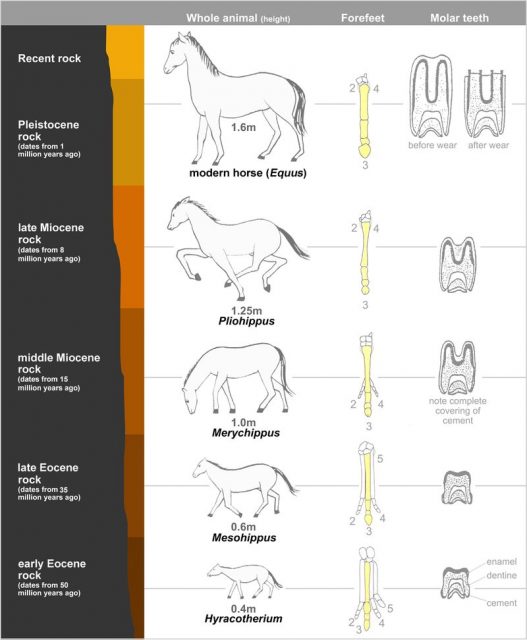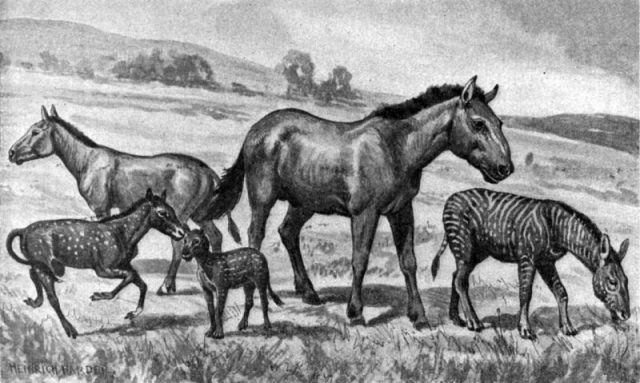You never know what you might turn up when you dig in your backyard, aside from bits of glass, rusty nails, and tulip bulbs. One couple in Utah undertaking a renovation project discovered what they thought was the skeleton of a cow. But it turned out to be a 16,000-year-old horse. Talk about a buried treasure!
Horses are of course associated with the Wild West, but their lineage is not continuous. Horses lived in North America from 50 million years ago to 11,000 years ago, when they went extinct for reasons not fully understood. Million-year-old fossils of direct ancestors to modern-day horses have been discovered in Wyoming and Idaho, among other U.S. regions. Europeans re-introduced domesticated horses to the continent in the 15th and 16th centuries.
And though today we think of Utah as a dry state, much of the region was buried under water until 14,000 years ago. From around 500 million years ago, Lake Bonneville covered Utah and parts of surrounding Idaho and Nevada, at a depth of more than 1,000 feet, until it released through the Red Rock Pass in Idaho during a period of climate change. Today’s Great Salt Lake is a remnant of Lake Bonneville.

Evolution of horse. Photo: Mcy jerry CC BY-SA 3.0
Laura and Bridger Hill came across the skeleton in their yard in Lehi, Utah, in September 2017, when landscapers unearthed it during their backyard renovation. The bones had been preserved beneath seven feet of sandy clay. At first, the Hills thought it was the skeleton of a cow, as the area used to be farmland around the edges of Utah Lake. For months, they left the uncovered bones, which were exposed to air, the prodding of curious children, and the abuse of landscaper equipment.
But eventually, the Hills showed the bones to their neighbor, who happens to be a geologist at nearby Brigham Young University. He told them he suspected the skeleton was from the Pleistocene Age. The Hills then turned to bones over to the Museum of Ancient Life, also in Lehi.
Rick Hunter, a paleontologist at the museum who is making a study of the bones, said the horse bones were well preserved, which indicates it was buried soon after it died. Hunter speculated that the horse may have been trying to escape a predator or may have drowned in an upstream river and floated down to the lake. Because the bones were in a former lake bed, they remained moist for thousands of years.

Skeletal evolution of horses. Photo: H. Zell CC BY-SA 3.0
Hunter visited the site and fascinated local children with impromptu talks about fossils, paleontology, and the study of old bones. He told news outlets that it is unclear whether the horse was male or female but that based on arthritic-looking formations on its spine, it was likely older. A bone on one ankle has evidence of cancer. It was shorter and stockier than a modern-day horse, around the size of a Shetland pony. Its skull had been shattered and moved by the landscapers.

Illustration of extinct horses. From left to right: Mesohippus, Neohipparion, Eohippus, Equus scotti and Hypohippus.
Arid Utah is home to many sites where fossils of dinosaurs, saber-toothed tigers, mastodons, and mammoths have been discovered. Several sites have hundreds of well-preserved dinosaur footprints; there are dinosaur quarries where visitors can see hundreds of bones. The Museum of Ancient Life itself has 60 complete dinosaur skeletons, a mock quarry dig, and a functioning paleontology lab, where workers are uncovering real dinosaur bones.
Read another story from us: An archaeological dig on the Swedish island of Öland reveals a massacre that happened 1,500 years ago
But not that many people find 16,000-year-old bones in their backyards. The horse will be named the Hill Horse in honor of the family on whose land it was found. Laura Hill was pleased, according to the New York Times, saying to the paper’s reporter, “Now all these little kids want to be paleontologists.”
E.L. Hamilton has written about pop culture for a variety of magazines and newspapers, including Rolling Stone, Seventeen, Cosmopolitan, the New York Post and the New York Daily News. She lives in central New Jersey, just west of New York City
